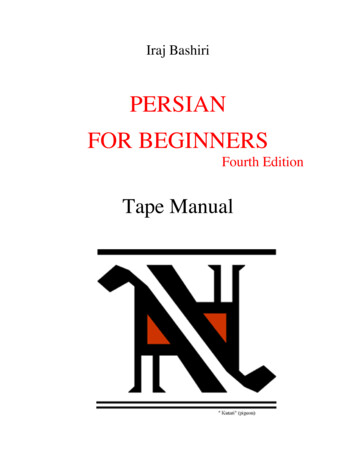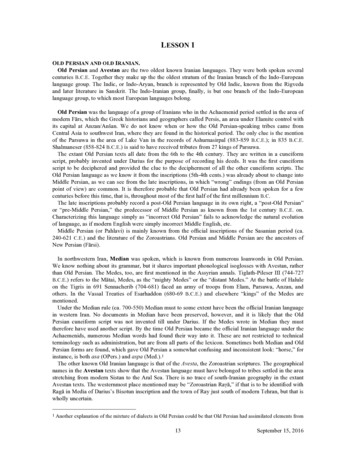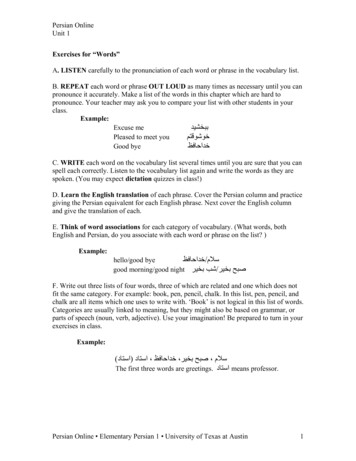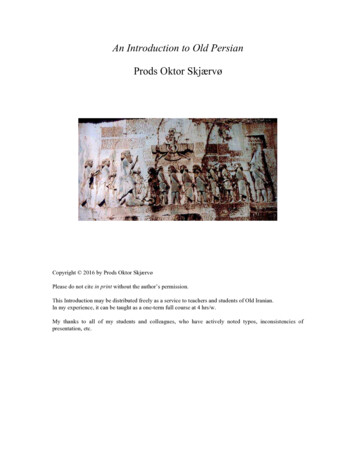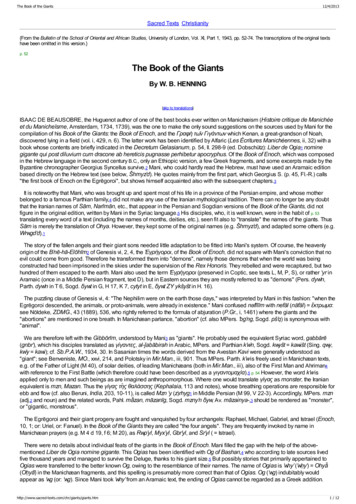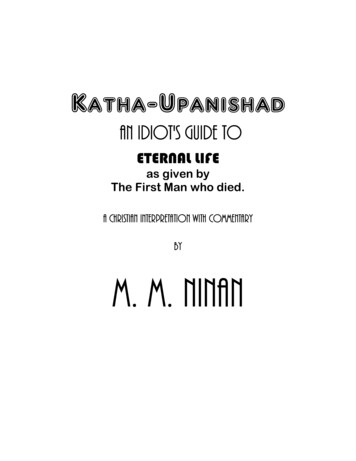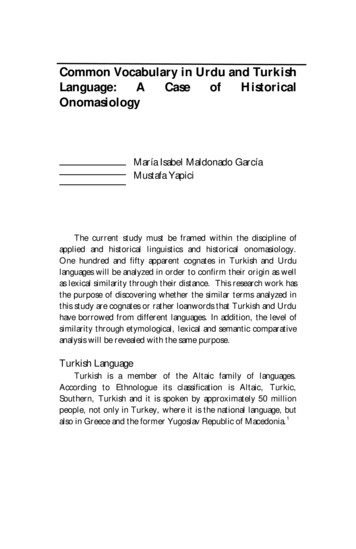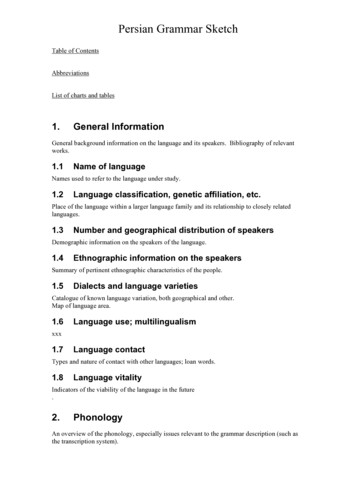
Transcription
AThousand Yearsof thePersian Book
A Thousand Yearsof the Persian BookPersian gained prominence as a literary language anda lingua franca—a common cultural language—aboutone thousand years ago. In the past millennium, a richand varied written and spoken heritage has developedin the Persian language, elevating the visibility ofPersian civilization among world intellectual traditions.That tradition is particularly strong in the fields ofstorytelling, poetry, folklore, and literature, withadditional important contributions in historiography,science, religion, and philosophy.From the tenth-century seminal Shahnameh (Bookof Kings) by Ferdowsi to the works of contemporarywriters, the Persian language has changed very littlein the last millenium. A Thousand Years of the PersianBook examines the richness and variety of the Persianbook and its literary tradition. It showcases the Library’sunique collections, which are among the most importantin the world today outside of Iran. The exhibitionfocuses on Iran but also includes items from the greaterPersian-speaking lands of Afghanistan and Tajikistan,as well as items from Central and South Asia and theCaucasus, illustrating the international nature of thePersian language. In addition to examining the diversityof literary styles, the exhibition demonstrates thecontinuity of the written word as a unifying culturalforce in Persian-speaking lands.Muḥammad Ahlī Shīrāzī. Detail of The Book of Licit Magic.Persia, 1545. Manuscript.Near East Section, African and Middle Eastern Division,Library of Congress (033.00.00)
Writing Systems and ScriptsThe Persian LanguagePersian scripts have evolvedover the last 3000 years, withthree major historic stages ofdevelopment, all on displayin this exhibition. In ancientPersia (650 BCE–330 BCE), OldPersian was inscribed in thecuneiform script, adapted fromthe Mesopotamian cultures ofthe ancient Near East. Duringthe pre-Islamic classical periodof the Parthian and SassanidPersian Empires (248 BCE–651),the Aramaic language gainedprominence in many regions ofthe Persian Empire, influencingthe language and writing systemof Pahlavi, the middle Persianlanguage. The script used forwriting Pahlavi was adapted fromthe ancient Aramaic script. Afterthe Islamization of Persia, (651–present), a modified Arabic scriptreplaced the older scripts.Along with ancient languagessuch as Sanskrit and Latin andliving languages such as English,French, Russian, and Hindi,Persian belongs to the IndoEuropean family of languages,specifically to the Iranian(Iranic) branch. Persian is alsoreferred to by local regionalnames such as Farsi in Iran,Dari in Afghanistan, and Tajikiin Tajikistan and Uzbekistan.However in English the historicname for the language has alwaysbeen “Persian.”Modern Persian is a continuationof the pre-Islamic Pahlavilanguage that has incorporatedmany Arabic and Islamic terms.Other writing scripts have alsobeen used for modern Persian.In medieval Persia amongPersian-Jewish communities,the Judeo-Persian language,which combines Persian withHebrew and Aramaic terms,was written using the Hebrewscript. In Central Asia duringthe late Czarist Russian period,a region subsequently controlledby the Soviet Union, the Persianspeaking populations used bothLatin and Cyrillic (modifiedRussian) scripts, which has sinceresulted in the modern TajikPersian script.The literary and culturallanguage of the Iranian plateau,the highlands, and plains ofCentral Asia has been Persian, alanguage also used extensivelythroughout South Asia. Forcenturies, rival empires fromthe Indian Mughal Empire inthe east to the Ottoman Empirein the Mediterranean and theBalkans used Persian languageand aesthetics to form the basisof a common tradition thatculturally united these vastregions. Today, Persian is spokenin Iran, Afghanistan, Tajikistan,and Uzbekistan.Pūr Davūd.Detail of The Hymns of The Holy Gathas.Bombay: Fort Printing Press, 1927.Near East Section, African andMiddle Eastern Division,Library of Congress (005.00.00)
The Epic of ShahnamehThe seminal work of Persian literature is theShahnameh, an epic poem that recounts thehistory of pre-Islamic Persia or Iranshahr(Greater Iran). The Shahnameh contains 62 stories,told in 990 chapters with 50,000 rhyming couplets.It is divided into three parts—the mythical, heroic,and historical ages. Written in modern Persian, theShahnameh is a work of poetry, historiography, folklore,and cultural identity and is a continuation of the ageold tradition of storytelling in the Near East.Under the patronage of the Samanid dynasty, HakīmAbul-Qāsim Firdawsī Tūsī (Ferdowsi) began his epicpoem in 977, taking thirty-three years to complete it.The Shahnameh was written at a time when modernPersian had started to flourish and the structures andstandards for the language were being set.After its first appearance in 1010, the Shahnamehdirectly affected the epic and poetic works of allPersian speakers and writers for centuries. A numberof scholars credit the continuity in modern Persian tothe Shahnameh. It influenced not just Persian speakersbut also the cultures of Turkic peoples in Central Asia,Azerbaijan, and the Ottoman Empire, as well as theGeorgian, Kurdish, and Pashto literary traditions. TheShahnameh continues to be one of the primary pillarsof the modern Persian language.Ferdowsi. Detail of Selections from the Shahnameh.Manuscript copied in Iran, 1618.Near East Section, African and Middle Eastern Division,Library of Congress (001.00.00)
ReligionThe religious works in the exhibition representconfessional and philosophical traditions of thevarious faiths practiced in the Persian-speakingworld today. By 650 BCE, the Zoroastrian faith, amonotheistic religion founded on the ideas of thephilosopher Zoroaster, had become the official religionof ancient Persia. Later, Judaism and then Christianitycame to Persia via Mesopotamia, with both developingvibrant faith communities in Persian lands. To the eastof the Persian Empire, the regional kingdoms of what isnow Afghanistan and Central Asia adopted Buddhismfrom India in the third century, blending it withZoroastrianism and Greek traditions.With the spread of Islam in the mid-seventh century,the Persian-speaking world became predominantlyMuslim although vestiges of the earlier pre-Islamicreligious and philosophical traditions remained. Sufism,a meditative and mystical path of Islam, evolved in theregion in the tenth century, while the Ismaili Shi itedoctrine became prominent in Persia by the eleventhcentury. During the Safavid dynasty (1501–1722),much of present Iran and Azerbaijan converted to theTwelver Shi ite sect of Islam. Newer faiths like theBaha’i Faith developed as late as the nineteenth centuryin Persia expanding to the Near East and beyond.Sayyid Ja‘far Abu. The Gift of the Kings and Their Practices.Tabriz, Iran: Nasiri Publishing House, 1856–1857.Near East Section, African and Middle Eastern Division,Library of Congress (012.00.00)
Science and TechnologyBeginning in ancient times Persia has been a centerof scientific achievement and was often the conduitof knowledge from China and India in the East toGreece and Rome in the West. Persian-speaking scholarshave been active in furthering knowledge in fields ofscience and technology, such as astronomy, chemistry,anatomy, biology, botany, cosmology, mathematics,engineering, and architecture.Ancient Sassanid Persia was home to some of the earliestuniversities and libraries of the ancient world. After theIslamization of Persia (651), middle Persian Pahlavi textsas well as Indian, Chinese, Greek, Aramaic, and Latinscientific texts were translated into Arabic. AlthoughArabic remains the primary language used for scientificwriting in the Islamic world, many scholars have alsoproduced a range of scientific manuscripts and worksin the Persian language. The Mughal court in India(1526–1858) became a major center for the production ofscientific works in Persian.Zakariya ibn Muhammad Qazvīnī.Detail of Marvels of Creation and Oddities of Existence. Persia, 1565. Manuscript.Near East Section, African and Middle Eastern Division,Library of Congress (016.00.00)
HistoryFrom the tenth century to the late nineteenthcentury, historical writing became one of the mostrevered and important literary traditions in thePersian language. These works were often written inprose as well as in verse. Most of the surviving historicalworks produced in the Persian-speaking world are fromthe Islamic period (651–present).Historians, scholars, rulers, and elites from variousregions of India, the Central Asian Khanates, thevarious city centers of Iran and Afghanistan, and theOttoman lands have produced a wide range of historicalmanuscripts and lithographic printed books in Persian.Subjects covered include travel literature, world history,current events, and traditional subjects such as thehistory of Islamic civilization.Beginning in the sixteenth century, as contact with theWest increased and as Western travel diaries and travelliterature became available to readers in Persian lands, anew tradition of Safarnamah (travelogue) writing spreadin the region. By the late nineteenth-early twentiethcentury Safarnamah literature became a mainstreamgenre in Persian historiography.Muḥammad Amīn ibn Abī al-Ḥusayn Qazvīnī.Detail of The Book of the King. India, 1825. Manuscript.Rare Book and Special Collections Division,Library of Congress (025.00.00)
LiteratureThe richness of Persian literature, one of theworld’s oldest, can be traced back to medievalclassical Persian. Beginning in the tenth centuryand lasting well into the sixteenth century, classicalPersian poetry and prose flourished. During thisclassical period, poetry became the dominant form ofliterary expression. It was the medium in which almostall intellectual pursuits were expressed, a traditionoften supported by royal patronage.By the eighteenth and nineteenth centuries, increasedcontact with Europe, especially with Russia and Britain,changed the traditions of writing poetry, literature,and history. However, Persian-speaking communities,which had for centuries prized Persian calligraphy as ahigh art form, did not immediately adopt the printingpress. From the mid-nineteenth century to the earlytwentieth century lithography became the preferredmedium used to print Persian books, since it couldbetter replicate calligraphic styles.During the early modern period, Persian literatureevolved to include genres in prose such as short stories,novels, satire, and humor. Persian writers introducednew themes related to nationalism and nationalidentity. Free verse poetry also found an audienceamong the new literary elites. Prose became animportant literary form and flourished in the twentiethand the twenty-first centuries. The number of authorsgreatly increased, and women writers gained muchhigher visibility. Today, Persian writers, some usingregional and national variations of the Persian language,continue to create poetry, prose, novels, short stories,essays, and children’s stories.Embossed leather book cover.Nineteenth-century Qajar Era. Kirkor Minassian Collection,Near East Section, African and Middle Eastern Division,Library of Congress (036.01.00)
Classical Persian PoetryCreated as highly illustrated manuscripts, thesemasterpieces of Persian poetry demonstrate theimportant place of literature, poetry, and bookmakingin the Persian-speaking world. From the tenth centuryto the sixteenth century Persian classical poetrydeveloped as a literary language by adapting the meterand rhyme scheme of the Arabic poetic tradition.Even the written works by philosophers, historians,and scientists were often delivered in verse. Duringthis period, three major styles of Persian poetrycame to prominence: the epic panegyric Khorasanistyle, developed around the tenth century in easternPersia; the Iraq-i ‘Ajami (Western Persian style) thatemerged in the thirteenth century, a lyrical style thatuses mystical Sufi concepts; and the Sabk-i Hindi (theIndian style), which emerged in the fifteenth century.Despite differences among the various styles, thereremains continuity in the poetic and aesthetic styles ofclassical Persian poetry, present in works produced asearly as the tenth century by the poet Rūdakī up to theworks of the fifteenth-century poet Jāmī.Shams al-Dīn Muhammad Hāfiz-i Shīrāzī.Detail of Anthology of Hāfiz. Persia, 1685. Manuscript.Near East Section, African and Middle Eastern Division,Library of Congress (030.00.00)
Eighteenth andNineteenth Century LiteratureModern nation states and distinct national identitiesemerged in the Persian-speaking region during theeighteenth and nineteenth centuries. During thistransitional period, as Persian speakers came intocontact with the West, a number of intellectualand social movements paved the way for changesto traditional structures of writing literature andbookmaking. Literary trends in Europe particularlyaffected the use of the Persian language and itsdevelopment in Iran, Afghanistan, India, and Turkestan(Central Asia). As lithographic Persian book printingbecame widespread, book publishing centers developedin Bombay, Tiblisi, Istanbul, Cairo, Tabriz, Tehran, Herat,Kabul, Samarkand, and Bukhara. Persian classics werereprinted during this period and short stories, novels,satire, and humor were introduced to regional massaudiences. The theme of nationalism in literature alsogained prominence.Detail of selections of classical Persian poetry.Iran, late eighteenth–early nineteenth century. Manuscript.Near East Section, African and Middle Eastern Division,Library of Congress (045.00.00)
Modern andContemporary LiteratureTwentieth- and twenty-first-century Persian literaturecontinues to evolve within a changing and sometimesdisruptive political climate in the region. In thetwentieth century, standardization of the Persianlanguage, a focus on education, and an engagementin social and political discourse became popularthemes throughout the region. Old poetic structures,seen as inadequate to reflect modern concerns, gaveway to vibrant and expressive methods of literaryself-expression. The region has also witnessed atremendous expansion in the number of genres andauthors from Iran, Afghanistan, and Tajikistan, as wellas from diaspora communities that continue to publishin Persian.Omar Khayyam. Detail of Rubáiyát. Translated by Edward FitzGerald withillustrations by Arthur Szyk. New York: Heritage Press, ca. 1946. Rare Book andSpecial Collections Division, Library of Congress (028.00.00) Reproduced withthe cooperation of The Arthur Szyk Society, Burlingame, California www.szyk.org
Women WritersWomen poets and authors have been producing importantliterary works in Persian for centuries. During themedieval period, Persian-speaking women who enjoyedroyal patronage or who were themselves from a privilegedclass received the benefits of education and had the meansand the opportunity to write and recite poetry. Medievalworks by women retained the structure of classicalPersian poetry, and their writings covered themesranging from love and humor to rebellion and sorrow,often expressed in a more intimate and personalizedmanner than poetry written by their male counterparts.As economic development and political stability grewin the sixteenth century in Safavid Persia and MughalIndia, poetry and written works by women became morewidespread there. By the nineteenth century, as partof a broader revival of Persian literary arts and a rise inuniversal education and social movements influenced bythe West, many more opportunities for women to writepresented themselves. Since the twentieth century therehas been a dramatic increase in the number of womenpoets and writers from Iran, Afghanistan, and Tajikistanwho have given voice to women’s perspectives. Today,the number of Persian-speaking women authors almostequals those of men, with their works often outsellingthose by men in the marketplace.‘Āyisha Durrānī. Collected Poems of ‘Āyisha Durrānī.Kabul: Bā bayārī-i Maṭbaʻ-i Sarkārī-i shahr-i Kābul-i gulgul bishkuft, 1881.Near East Section, African and Middle Eastern Division,Library of Congress (059.00.00)
Storytelling andChildren’s LiteratureWhether a lullaby, a grandmother’s bedtime story,or a tale from A Thousand and One Nights told by theheroine Scheherazade, the oral tradition of storytellinghas been prominent in the culture and traditions ofPersian speakers. For hundreds of years these storieshave formed a rich foundation for Persian authors ofchildren’s books.In the twentieth century, as universal education gainednational prominence, children’s books became animportant genre in Persian literature, aiming at not onlyentertaining but also educating and promoting culturalvalues. In Iran, Afghanistan, and Tajikistan a notablenumber of children’s books that are richly illustratedhave been produced. In the diaspora, Iranian and Afghancommunities have expanded the audience for theseworks by utilizing computer graphics, graphic novels,and animation, as well as translating into English manynoteworthy Persian titles.Ferdowsi. Detail of Shahnameh: The Epic of the Persian Kings, illustrated HamidRahmanian, translated Ahmad Sadri. New York: Quantuck Lane Press, 2013.Near East Section, African and Middle Eastern Division,Library of Congress (073.00.00) Hamid Rahmanian
AcknowledgmentsA Thousand Years of the Persian Bookwas developed under the leadership ofJames H. Billington, the Librarian of Congress.The exhibition was made possible throughthe generous support of thePublic Affairs Alliance of Iranian Americansand Ambassador Hushang Ansary12Jawad Kamel;Nazie Eftekhari in honor of her parents,Mrs. Homa (Arbab) Eftekhari and Mr. Mehdi Eftekhari12Farshid Francis and Dionne Najafi,Pivotal FoundationForough and Mori HosseiniMinoo and Faraj Saghri12Bita Daryabari and Dr. Reza MalekNader A. MousaviFaramarz “Fred” FardshishehShoaleh and Asghar NosratiLaya and Hamid BiglariStephanie and Fred PezeshkanAli EbrahimiNancy Bagley and Soroush ShehabiSherry S. Bahrambeyguiand Patrick L. HoseyFahimeh Nouriani and Farhad SaadatMeriel and Akbar LariGita Khadiri and Fred KhoroushiHaida and Ali MojdehiHamid NoshirvaniDon Bering, Calibre Motors, Inc.Mehdi Haidarali,Sanie Manufacturing Company, Inc.Exhibition TeamWilliam Jacobs, Chief, Interpretive Programs OfficeCynthia Wayne, Exhibition Director, Interpretive Programs OfficeKaren Werth, Production Officer, Interpretive Programs OfficeChristopher O’Connor, Lead Exhibition Specialist, Interpretive Programs OfficeTambra Johnson, Registrar, Interpretive Programs OfficeExhibition CuratorsMary-Jane Deeb, Chief, African and Middle Eastern DivisionHirad Dinavari, Iranian World Reference Specialist, African and Middle Eastern DivisionChristopher Murphy, Head, Near East Section, African and Middle Eastern DivisionInterpretive Programs Office StaffDenise Agee, Kimberli Curry, Vicki Fortuno, Martha Hopkins, Carroll JohnsonWelsh, David Jung, Susan Mordan-White, Betsy Nahum-Miller, Cheryl Regan,Marc Roman, Patrick Shepler, and Rachel Waldron.Special thanks are due to the following members of theLibrary of Congress staff for their assistance with this exhibition:Roberta I. Shaffer, Library Services; Jeremy Adamson, Collections and Services;Sharon Horowitz, African and Middle East Division; Kaare Chaffee, Claire Dekle,Yasmeen Khan, Dan Paterson, Tessa Gadomski, and Simonette dela Torre,Conservation Division; Sue Siegel, Development Office; Domenic Sergi, Andrew Cook,and Jade Curtis, Digital Scan Center; Cynthia A. Smith, Geography and Map Division;Stanley Bandong, Graphic Arts Services Unit; Karen Chaput, Information TechnologyServices; Bryan E. Cornell, Motion Picture, Broadcasting and Recorded Sound Division;Mary Wheeler, Printing Management Section; Donna Urschel, Public Affairs Office;Dan de Simone, Rare Book and Special Collections; Jim Karamanis, Thip Padavong,Rohit Gupta, Laura Moiseev, Chun Yi, and Qun Lai, Web Services.The Library also wishes to express gratitude to thefollowing individuals for their assistance and expertise:Dr. Fatemeh Keshavarz, Director, and Dr. Ahmad Karimi-Hakkak, Roshan Centerfor Persian Studies, University of Maryland; and Dr. Ulrich Marzolph, University ofGöttingen, Germany.Exhibition DesignShveima Associates, Charlottesville, VirginiaOnline ResourcesA digital version of this exhibition is available on theLibrary of Congress website, www.loc.gov/exhibits.
Thomas Jefferson Building10 First StreetWashington, DC 20540
medium used to print Persian books, since it could better replicate calligraphic styles. During the early modern period, Persian literature evolved to include genres in prose such as short stories, novels, satire, and humor. Persian writers introduced new themes related to nationalism and national identity. Free verse poetry also found an audience


